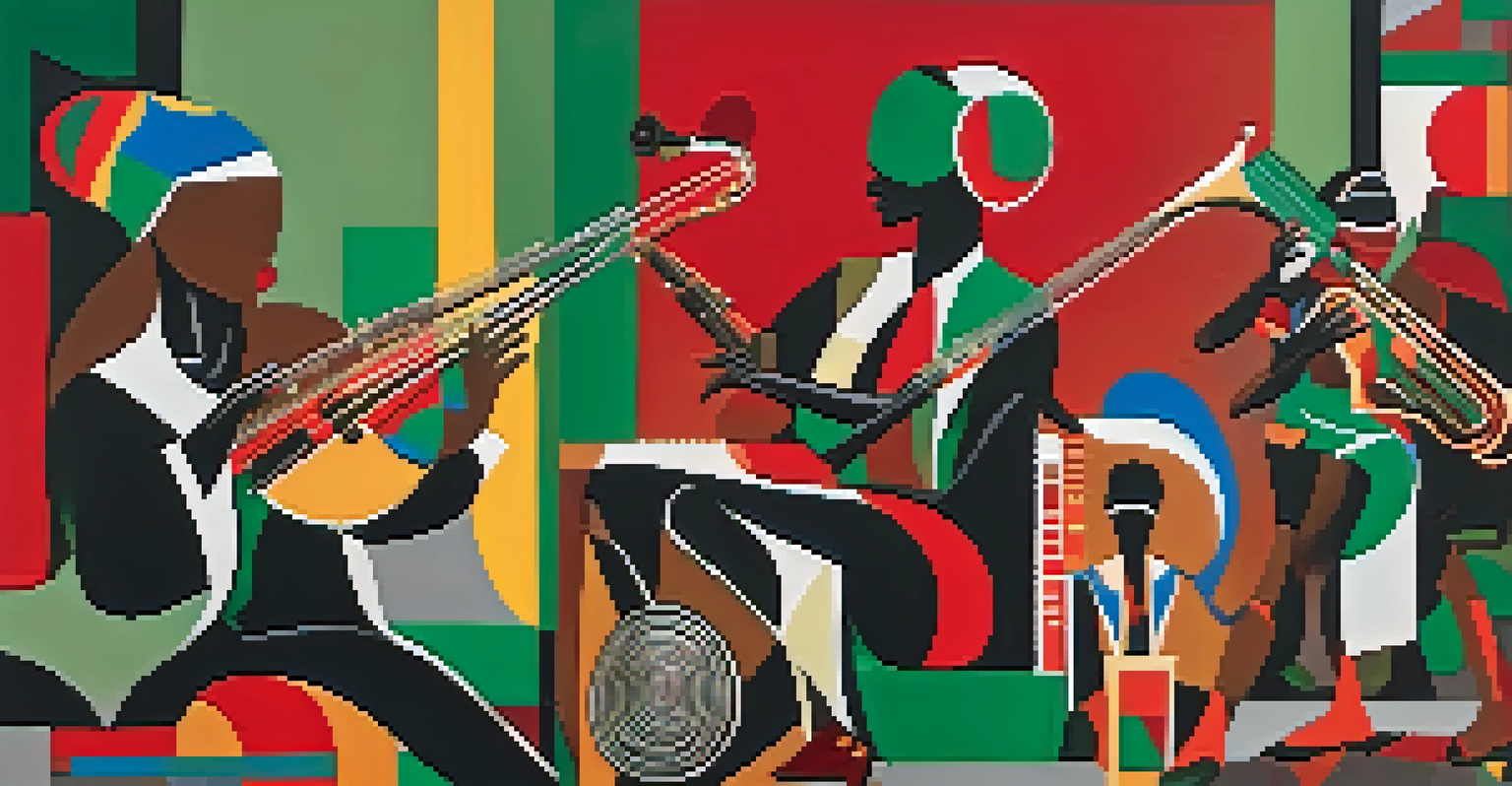The Significance of Art Movements in Historical Contexts

Understanding Art Movements and Their Role
Art movements are defined periods during which artists share a common philosophy or style. They often emerge in response to societal changes, political events, or technological advancements. For example, the Impressionist movement arose in the late 19th century, challenging traditional techniques and perspectives in art. This shift not only influenced painting but also reflected broader changes in society's views on nature and perception.
Art is the most beautiful of all lies.
By studying these movements, we gain insight into the cultural and historical contexts that shaped them. Each movement serves as a time capsule, capturing the emotions, struggles, and aspirations of the people who lived during that era. For instance, the Surrealist movement of the early 20th century was influenced by the horrors of World War I, leading artists to explore dreams and subconscious thoughts as a means of coping.
Related Resource
Ultimately, understanding art movements allows us to appreciate how art mirrors life. Just like a conversation, art evolves over time, responding to the world around it. Recognizing these connections enriches our experience of art and deepens our understanding of history.
The Influence of Historical Events on Art
Historical events often act as catalysts for artistic innovation and expression. For example, the Renaissance emerged during a time of significant change in Europe, marked by the rediscovery of classical philosophy and science. Artists like Leonardo da Vinci and Michelangelo produced works that not only showcased their talent but also reflected the humanistic ideals of their time.

Similarly, the political turmoil of the early 20th century led to the rise of movements like Dadaism, which rejected traditional aesthetics in favor of chaos and absurdity. Artists like Marcel Duchamp challenged conventional notions of art, creating a dialogue about the very nature of creativity during a time of uncertainty. This reaction to historical context emphasizes how art can serve as both a reflection and critique of society.
Art Reflects Historical Context
Art movements often emerge in response to significant historical events, providing insight into the cultural and societal changes of their time.
By examining how art movements respond to historical events, we gain a broader understanding of their significance. These movements not only document the cultural climate but also influence future generations of artists. In this way, art becomes a vital record of human experience.
Cultural Shifts and Their Artistic Representations
Art movements often emerge alongside cultural shifts, mirroring the changing values and beliefs of society. The Harlem Renaissance, for example, celebrated African American culture and heritage in the early 20th century. Artists like Langston Hughes and Aaron Douglas used their work to express the struggles and triumphs of their community, fostering pride and awareness.
Every artist dips his brush in his own soul, and paints his own nature into his pictures.
This movement was not just about art; it was a powerful cultural revival that challenged racial stereotypes and promoted social justice. Through music, literature, and visual arts, the Harlem Renaissance left an indelible mark on American culture, showcasing how art can be a vehicle for social change. It illustrated the importance of representation and gave voice to those who had been marginalized.
Related Resource
Cultural shifts continue to shape contemporary art movements, demonstrating the ongoing dialogue between art and society. As we navigate complex issues like identity, gender, and climate change, artists today draw on their experiences to respond creatively. This interplay ensures that art remains relevant and reflective of our shared human experience.
The Role of Technology in Art Movements
Technology has historically played a significant role in the evolution of art movements. The invention of the camera in the 19th century, for instance, revolutionized how artists approached their work. With the ability to capture real-life images, artists like the Impressionists shifted their focus towards capturing light and color rather than mere representation, fundamentally changing the landscape of art.
In the contemporary era, digital technology has opened new avenues for artistic expression. From digital painting to virtual reality installations, artists are exploring innovative mediums and techniques that were previously unimaginable. This technological shift not only expands the tools available to artists but also influences how audiences engage with art, creating immersive experiences that challenge traditional boundaries.
Cultural Shifts Influence Art
Art movements mirror cultural shifts and changing societal values, serving as a powerful vehicle for social change and representation.
As technology continues to advance, it will undoubtedly shape future art movements in ways we can't yet predict. This ongoing relationship between art and technology highlights the adaptability of artistic expression, reinforcing the notion that art is a reflection of its time. Understanding this interplay is crucial for appreciating the significance of contemporary art.
Art Movements as Reflections of Ideology
Art movements often embody the ideologies of their time, whether political, social, or philosophical. For instance, the Russian Constructivism movement emerged after the Bolshevik Revolution, promoting the idea that art should serve a social purpose. Artists like El Lissitzky and Alexander Rodchenko sought to create works that inspired collective action and reflected the ideals of a new socialist society.
These ideological underpinnings reveal how art can be used as a tool for advocacy and transformation. Similarly, the Feminist Art Movement of the 1970s challenged the patriarchal norms of the art world, demanding recognition and representation for women's voices and experiences. Artists like Judy Chicago and Miriam Schapiro redefined what art could be, asserting its role in shaping societal change.
Related Resource
By examining the ideologies behind different art movements, we gain a deeper understanding of their significance. Art not only reflects societal values but also has the power to influence them, making it a crucial component of cultural discourse. This dynamic relationship highlights the importance of engaging with art on both an aesthetic and ideological level.
The Globalization of Art Movements
In today's interconnected world, art movements are increasingly influenced by globalization. Artists draw inspiration from diverse cultures, leading to hybrid styles that reflect a blend of traditions and perspectives. For example, the contemporary art scene often features influences from African, Asian, and Latin American cultures, challenging the Eurocentric narratives that have dominated art history.
This globalization allows for a richer dialogue between artists and audiences, fostering cross-cultural understanding and collaboration. Artists like Ai Weiwei and Yoko Ono use their work to address global issues such as human rights and environmental concerns, transcending geographical boundaries. Their art speaks to universal themes, resonating with audiences worldwide and reflecting shared human experiences.
Technology Shapes Artistic Expression
Advancements in technology have historically transformed art movements, enabling new creative mediums and altering how audiences engage with art.
As art becomes more globalized, it challenges us to rethink our understanding of cultural identity and representation. It emphasizes the importance of inclusivity and diversity within the art world, ensuring that a multitude of voices are heard. This evolution not only enriches artistic expression but also reflects the complexities of our contemporary society.
The Enduring Legacy of Art Movements
The legacy of art movements extends far beyond their time, influencing generations of artists and shaping cultural landscapes. Iconic movements like Cubism and Abstract Expressionism continue to inspire contemporary artists, who draw on their principles while pushing the boundaries of artistic expression. This ongoing dialogue highlights the relevance of past movements in today’s art world.
Moreover, art movements often pave the way for new forms of creativity and experimentation. The Beat Generation, for instance, not only impacted literature but also influenced visual artists, musicians, and filmmakers. This interconnectedness reinforces the idea that art is not created in isolation; it evolves through collaboration and exchange across disciplines.

Understanding the enduring legacy of these movements enriches our appreciation of art as a dynamic force in society. By recognizing the impact of historical contexts, we can celebrate the ways in which art continues to shape our understanding of the world. This journey through art history reminds us that every brushstroke, every note, and every word contributes to the vibrant tapestry of human culture.